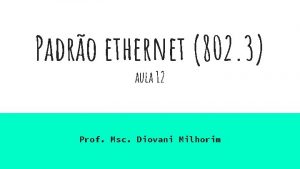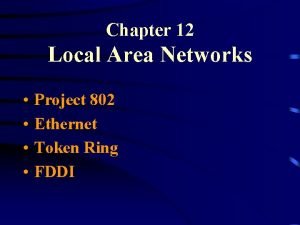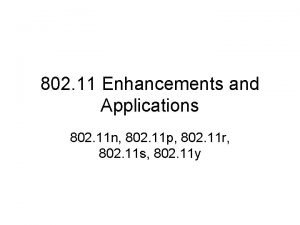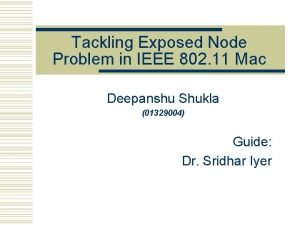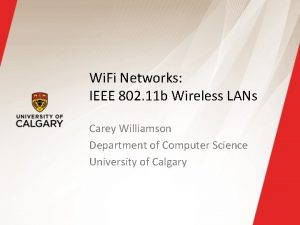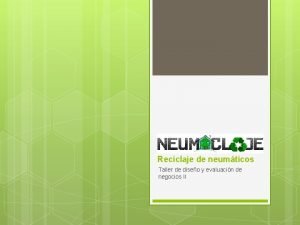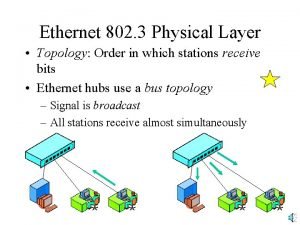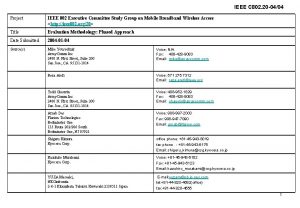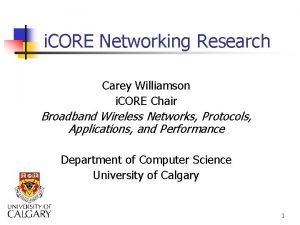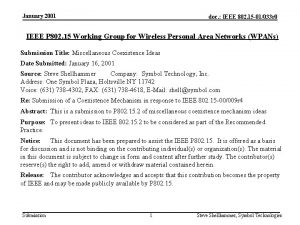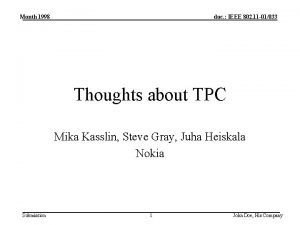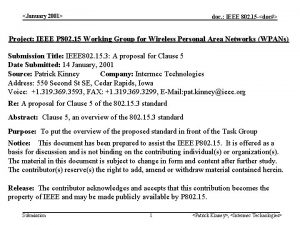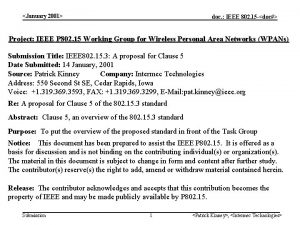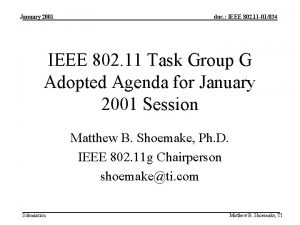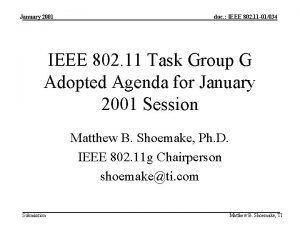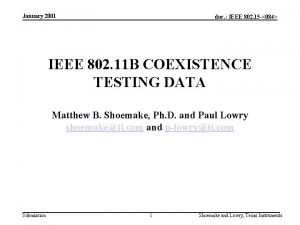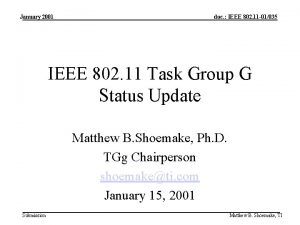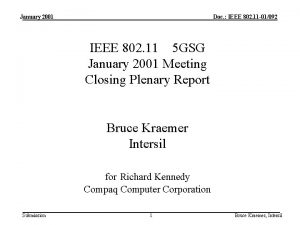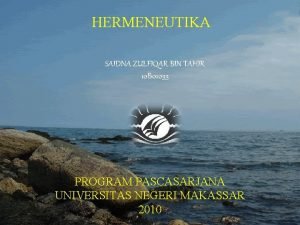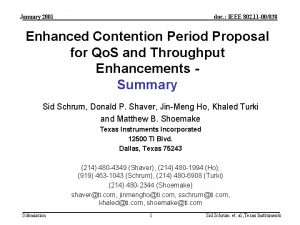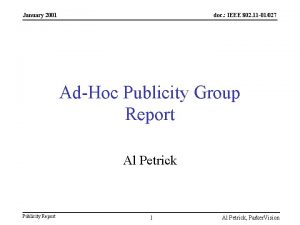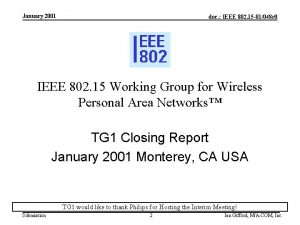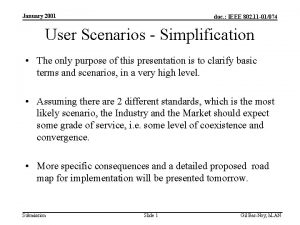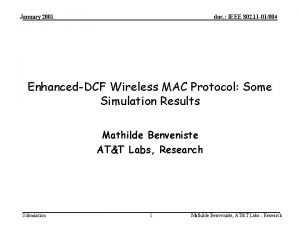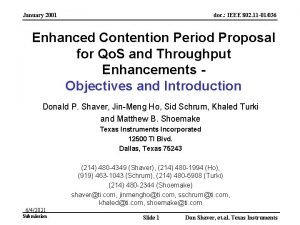January 2001 doc IEEE 802 15 01033 r




















- Slides: 20

January 2001 doc. : IEEE 802. 15 -01/033 r 1 IEEE P 802. 15 Working Group for Wireless Personal Area Networks (WPANs) Submission Title: Miscellaneous Coexistence Ideas Date Submitted: January 16, 2001 Source: Steve Shellhammer Company: Symbol Technology, Inc. Address: One Symbol Plaza, Holtsville NY 11742 Voice: (631) 738 -4302, FAX: (631) 738 -4618, E-Mail: shell@symbol. com Re: Submission of a Coexistence Mechanism in response to IEEE 802. 15 -00/009 r 4 Abstract: This is a submission to P 802. 15. 2 of miscellaneous coexistence mechanism ideas Purpose: To present ideas to IEEE 802. 15. 2 to be considered as part of the Recommended Practice. Notice: This document has been prepared to assist the IEEE P 802. 15. It is offered as a basis for discussion and is not binding on the contributing individual(s) or organization(s). The material in this document is subject to change in form and content after further study. The contributor(s) reserve(s) the right to add, amend or withdraw material contained herein. Release: The contributor acknowledges and accepts that this contribution becomes the property of IEEE and may be made publicly available by P 802. 15. Submission 1 Steve Shellhammer, Symbol Technologies

January 2001 doc. : IEEE 802. 15 -01/033 r 1 IEEE P 802. 15 Working Group for Wireless Personal Area Networks. TM Miscellaneous Coexistence Ideas Submission 2 Steve Shellhammer, Symbol Technologies

January 2001 doc. : IEEE 802. 15 -01/033 r 1 Purpose of This Submission • This submission is not a standalone Coexistence Mechanism • This presentation includes several ideas that may be useful in combination with a coexistence mechanism • It is not my intent for this submission to be voted on. • TG 2 can select any of these ideas to supplement a Coexistence Mechanism Submission 3 Steve Shellhammer, Symbol Technologies

January 2001 doc. : IEEE 802. 15 -01/033 r 1 Preferred 802. 11 b Data Rate • There are four data rates in 802. 11 b – 1, 2, 5. 5 and 11 Mbps • The higher the data rate the lower processing gain – This implies lower data rates are better in the presence of interference • The higher the data rate the shorter the duration of the packet – This implies higher data rates are better in the presence of interference Submission 4 Steve Shellhammer, Symbol Technologies

January 2001 doc. : IEEE 802. 15 -01/033 r 1 Preferred 802. 11 b Data Rate • These two observations are in opposition • It has been observed that the benefits of having shorter packets more than offsets the decrease in processing gain, by going to higher rates • IT IS BEST TO USE THE HIGHEST DATA RATE IN 802. 11 B Submission 5 Steve Shellhammer, Symbol Technologies

January 2001 doc. : IEEE 802. 15 -01/033 r 1 Data Rate Scaling in 802. 11 b • IEEE 802. 11 b allows for automatic data rate scaling • How data rate scaling is implemented is not specified in the IEEE Standard • The intent of automatic data rate scaling is to increase the range of the network, at the expense of data rate • Detect edge-of-range and then rate scale Submission 6 Steve Shellhammer, Symbol Technologies

January 2001 doc. : IEEE 802. 15 -01/033 r 1 Data Rate Scaling in 802. 11 b • Since the rate scaling algorithm is not in the standard we cannot make too broad a statement about the effect of interference • It is possible for Bluetooth interference to fool the rate scaling algorithm to believe it needs to decrease the data rate. Submission 7 Steve Shellhammer, Symbol Technologies

January 2001 doc. : IEEE 802. 15 -01/033 r 1 Data Rate Scaling in 802. 11 b • Bluetooth interference may cause the rate scaling algorithm to decrease the 802. 11 b data rate. • Since decreasing the data rate increases the effect of interference, we have Positive Feedback, resulting in a quick drop in data-rate to 1 Mbps. Submission 8 Steve Shellhammer, Symbol Technologies

January 2001 doc. : IEEE 802. 15 -01/033 r 1 Data Rate Scaling in 802. 11 b • IF THE DATA-RATE SCALING ALGORITHM IS FOOLED BY BLUETOOTH INTERFERENCE THEN DISABLE IT AND SET THE DATA RATE AT A FIXED RATE, AS HIGH AS POSSIBLE Submission 9 Steve Shellhammer, Symbol Technologies

January 2001 doc. : IEEE 802. 15 -01/033 r 1 Bluetooth SCO Link • The Bluetooth SCO Link is a periodic transmission every six Bluetooth slots – 2 out of 6 slots used (No FEC) – 4 out of 6 slots used (2/3 -rate FEC) – 6 out of 6 slots used (1/3 -rate FEC) • The SCO packets do not include a CRC and retransmission is not allowed. Submission 10 Steve Shellhammer, Symbol Technologies

January 2001 doc. : IEEE 802. 15 -01/033 r 1 Bluetooth SCO Link • The SCO Link, as an interferer, represents periodic interference with a short period (3. 75 ms). • If the Bluetooth power level at the 802. 11 receiver is too high, then this periodic interferer is potentially a worse interferer than an ACL Link. Submission 11 Steve Shellhammer, Symbol Technologies

January 2001 doc. : IEEE 802. 15 -01/033 r 1 Bluetooth SCO Link • The SCO Link is more susceptible to 802. 11 interference than an ACL Link – Interference it is more likely to cause full packet errors, not a few bit errors – The FEC does very little to mitigate the effect of interference – The SCO link does not support Packet Retransmission, which is what is needed in an interference environment Submission 12 Steve Shellhammer, Symbol Technologies

January 2001 doc. : IEEE 802. 15 -01/033 r 1 Bluetooth SCO Link • THE SCO LINK IS WEAK IN AN INTERFERENCE ENVIRONMENT • RECOMMENDATION: – ELIMINATE 1/2 -RATE AND 1/3 -RATE FEC – REPLACE IT WITH A NEW SCO LINK WITH UP TO TWO RETRANSMISSIONS – NEED TO ADD CRC TO SCO Submission 13 Steve Shellhammer, Symbol Technologies

January 2001 doc. : IEEE 802. 15 -01/033 r 1 Look-Ahead CCA in Bluetooth • Currently Bluetooth does not include Clear Channel Assessment • To make CCA useful in Bluetooth it would need to detect other wireless systems, not just Bluetooth devices • Use Receive Signal Strength Indicator to detect other wireless systems Submission 14 Steve Shellhammer, Symbol Technologies

January 2001 doc. : IEEE 802. 15 -01/033 r 1 Look-Ahead CCA in Bluetooth • In an ACL Link the Slaves can only transmit if the Master sent a packet in the previous slot • For ACL link you could add CCA only to the Master and have it check the current and next frequency. • Have the Master look ahead one frequency, to ensure it is clear. Submission 15 Steve Shellhammer, Symbol Technologies

January 2001 doc. : IEEE 802. 15 -01/033 r 1 Look-Ahead CCA in Bluetooth • Bluetooth allocates about 220 s for the frequency synthesizer to tune to the next frequency. • This is quite long and it is possible to design a synthesizer that tunes to a different frequency faster at a reasonable cost. • So look ahead to the next frequency and check for a clear channel. Submission 16 Steve Shellhammer, Symbol Technologies

January 2001 doc. : IEEE 802. 15 -01/033 r 1 Look-Ahead CCA in Bluetooth BT Tune to fn 220 s BT Tune to fn+1 with 80 s CCA Submission Transmission Time 405 s CCA 60 s 17 Tune to fn 80 s Steve Shellhammer, Symbol Technologies

January 2001 doc. : IEEE 802. 15 -01/033 r 1 Power Spectral Density of 802. 11 b • In the Coexistence Modeling Results it was observed that the 802. 11 b spectral mask is not very strict. • With the use of a better raised-cosine filter it is possible to bring the 802. 11 b Power Spectral Density down more than 50 d. B, when the specification is only 30 d. B down. Submission 18 Steve Shellhammer, Symbol Technologies

January 2001 doc. : IEEE 802. 15 -01/033 r 1 Power Spectral Density of 802. 11 b • USE A RAISED-COSINE FILTER WITH A ROLL-OFF COEFFICIENT OF ONE. Submission 19 Steve Shellhammer, Symbol Technologies

January 2001 doc. : IEEE 802. 15 -01/033 r 1 Summary • Presented several observations about Bluetooth and 802. 11 Coexistence – Impact of 802. 11 b Data Rates – Impact of 802. 11 b Rate-Scaling Algorithm – Weakness of the Bluetooth SCO Link – Look-ahead CCA in Bluetooth – Improved spectral mask for 802. 11 b Submission 20 Steve Shellhammer, Symbol Technologies











